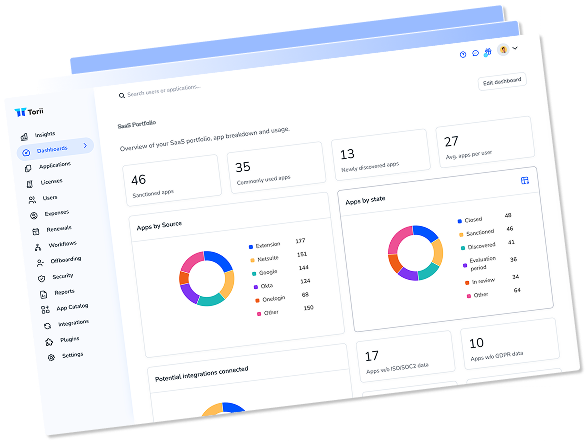With the new year, and a whole new decade, already underway, it’s important to know what pressing IT issues and concerns modern organizations are facing.
Given the speed at which the IT technology landscape changes, IT managers need to constantly adjust their skills and priories. By understanding the implications of these trends, IT managers can make the right technology decisions and can maximize the value that their expertise has to offer their companies.
1. Cybersecurity threats are more complex
In our survey of IT leaders a few months back, security was the most commonly selected top concern. Along with cost, security is a top factor for IT experts when selecting SaaS apps. In 2023, security has become even more important to our industry’s agenda. Cyberattacks are expected to intensify in scale and complexity, especially considering how 5G offers unprecedented data theft speeds.
Hackers no longer pinpoint the larger banks, insurance companies and governmental agencies but are going after companies of all sizes and turning us all into targets. They are using more sophisticated methods, abusing personal information while deploying artificial intelligence (AI) to power their cyberattacks.
Web apps, browser extensions and native mobile apps are being targeted systematically to identify and exploit vulnerabilities. Public wifi networks and charging stations are becoming more hazardous. Just recently, a North Korean hacker group was reported to be using a sophisticated “fileless” technique to compromise Mac systems. The hackers used malware that executes in-memory to remain stealthy. This allows the malware to evade antivirus solutions that mainly scan files to detect malware. What’s more, AI-powered phishing emails are now more personalized, increasing their ability to trick users into believing that they are legitimate messages.
Organizations need to keep up with and anticipate cybercrime mainstays, game changers, and new players. For IT managers, this means that you need to intensify your cybersecurity measures and avoid incomplete and hurried patches to be able to keep up with these newer forms of attacks. You must ensure that the rest of your IT team, and even line-of-business team members, are made aware of these threats, are educated on how they can be mitigated and are given the right tools to cope with the constant threats.
2. More workloads headed to the cloud
Adoption of software-as-a-service (SaaS) is continuing to grow. According to a NetEnrich survey, 80 percent of large enterprises claim that they have now shifted at least a quarter of their workloads and applications to the cloud. Most are keen on increasing their cloud investments with 73 percent of organizations indicating that nearly all their apps will be SaaS by 2023. And much of this activity is happening unilaterally, without IT even knowing about it.
Cloud computing has made it simpler to adopt new technology without IT’s involvement, with employees simply provisioning their own cloud resources; millennials open their own work accounts with the web apps they know; line-of-business managers have greater autonomy to equip their teams with the right solutions, and departmental “ops” teams manage their tech stacks independently.
For IT teams, the pressure to stay on top of the devices and software is only likely to increase. As we’ve seen with our customers, this trend of decentralized IT decision making has its pros and cons. While teams and staff are empowered to choose the tools that make them most productive, concerns such as shadow IT, security vulnerabilities, redundant spending and data silos have also cropped up.
Featured Video: What is Shadow IT? [Explainer]
While the younger workforce may have the technical savvy to deploy new apps and services on their own, they often lack awareness of potential security risks. Whereas traditional security training often focused on workstation, local server and email safety, organizations with decentralized IT environments must now prioritize more targeted education around cloud platform procurement and use.
Fortunately, solutions like Torii help minimize the risks that shadow IT brings. Automated discovery and custom workflows allow IT teams to effectively keep tabs on all instances of SaaS use and keep it all under supervision. This helps IT professionals shift their day-to-day focus from gatekeeping and policy enforcement to directly supporting business objectives based on enabling technology.
3. Workers embrace collaboration
IT managers should also recognize how organizational modes and methods of working are changing, with collaboration being the new normal in the workplace. The team collaboration software industry is on the rise, as organizations strive to boost their productivity and efficiency. Such tools include communication, project and task management, file sharing and co-creation tools.
These mostly online solutions keep the convenience of end-users top of mind, and work particularly well for remote teams and employees who need to collaborate on common tasks. Outsourcing and freelancing are also expected to continue growing into 2023. This will likely result in more projects to be worked on by geographically distributed teams, which rely on collaboration tools to operate.
These software products facilitate collaboration with functionalities like file sharing, task management, deadline setting and threaded discussions. If IT is going to facilitate digital collaboration, then you’re going to need ways to contend with the pitfalls of sensitive assets, data and conversation being shared over the cloud. Without proper access governance and privacy options, third parties may get inadvertent access to privileged information and even worse, teams can accidentally lose important data.
Because of these risks, IT managers must factor in privacy, security, control, and data loss prevention when enabling collaboration efforts. Make sure you have mechanisms in place to quickly discover and react to all access permission changes.
4. Connectivity is improving
When it comes to mobile infrastructure, we’re expecting to see the wider availability of 5G around the world in 2023. The new standard promises increased bandwidth and allows for faster internet speeds and lower latency, opening up the field for technologies like the internet of things (IoT) and cloud-based apps to perform better. These developments may encourage organizations to increase their investments in these technologies.
However, IT managers must identify potential bottleneck issues. This can be similar to a few years ago, when some infrastructures were still using Fast Ethernet switches and Wireless N routers while newer devices started to ship with gigabit network adaptors. The lower-capacity legacy devices created bottlenecks that prevented new devices from being utilized to their full potential.
Upgrading network components could come at a significant price, as older hardware may not even be compatible with the new standards. Legacy systems may also have delayed support or updates that would allow them to work. IT managers have to be aware of these potential issues, and do a lot of due diligence testing, before committing to wider-scale adoption.
When vetting an updated infrastructure, keep in mind that with 5G comes a larger attack surface and more devices accessing the network. Companies must ramp up security strategies to stay protected
5. Stricter privacy regulations
Data regulations like Europe’s General Data Protection Regulation (GDPR) and the recently deployed California Consumer Privacy Act (CCPA) have become key concerns for many IT leaders. These laws hold companies accountable for misuse and theft of customer data – even if your company’s servers are air-tight, you’re also responsible for the private data that you share with third-party services like SaaS apps.
Though both GDPR and CCPA are geography based regulations, they affect any organization working with companies or serving individuals from the EU and California, respectively. Other territories are also working on their own versions of the regulations.
This effectively puts the onus on you to disclose details relating to your audience data collection and storage policies, and to ask for website visitors to actively consent to these practices. Beyond that, you may be asked to prove that any application deployed by your organization complies with these provisions. Failure to comply could mean millions of dollars in fines for large enterprises. As such, IT managers must be extra vigilant at how their organizations gather, process, store and share data, including staying on top of the third-party applications that have access to your company’s data.
IT managers, managing IT
To stay relevant and overcome these challenges, IT managers need to commit to constant professional development. Here are some things you can do to stay on top of these trends:
- Align technology adoption to business goals. You must lead strategic efforts and ensure that technology use is geared towards meeting business goals. This enables organizations to achieve better returns on leaner technology spending and investments, while minimizing risks and vulnerabilities.
- Leverage emerging technologies. Strive to work smart. Fortunately, there are plenty of IT management solutions that leverage AI, automation and analytics to help teams operate more efficiently.
- Upgrade skill sets. New technologies and concerns are bound to come out in the future. Commit to self-development by constantly upgrading their skills. This not only includes technical skills but also people and management skills as well.
- Be creative on all fronts.- When it comes to technology as well as human resources, make sure to bring into your team the richest set of skills tools that can identify what’s risking your corporate tech stack and bit it.
By doing so, you are bound to continue delivering value to your company and underscore your relevance in today’s tech-driven business landscape.
A shorter version of this article previously appeared in Forbes.

